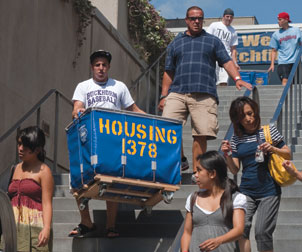At Two Years Old, Pitt's Outside the Classroom Curriculum Remains Vibrant, Becomes Ingrained in Students' Lives
 A scene from Arrival Survival during Pitt's 2009 Orientation Week.
A scene from Arrival Survival during Pitt's 2009 Orientation Week.The University of Pittsburgh’s Outside the Classroom (OCC) Curriculum is becoming an integral part of student life on the Pittsburgh campus, with program administrators working to keep OCC relevant and easy for students to use.
In fact, the program has gained enough momentum that students have been known to pass up free pizza in favor of activities that offer OCC credit.
As unbelievable as that sounds, “we’ve seen it,” says Shawn Brooks, OCC senior project manager, associate dean of students, and director of residence life. “Students will walk by as organizers say, ‘Free pizza!’ and the students keep walking. Then the organizers say, ‘You can also get OCC credit,’ and students turn around and come back.”
OCC began at Pitt in 2008 as an initiative to give students a competitive edge in their college careers and postgraduation job searches. The voluntary Universitywide program encourages students to participate in extracurricular programs and experiences, such as joining a student club, serving as a facilitator in peer-mentor programs, writing a résumé, or assisting with fundraising for the arts. A wide range of activities earns OCC credits, and students’ participation in the program is documented on their academic transcripts.
The brainchild of Kathy W. Humphrey, Pitt vice provost and dean of students, OCC focuses on nine key areas: leadership development, career preparation, communication skills, healthy lifestyle, understanding diversity, a sense of self, community participation, appreciation for the arts, and service to others.
“OCC has exceeded our expectations,” Brooks says. “In some ways, OCC became a part of our vernacular more quickly than we’d expected.”
During OCC’s first year, when the program was presented only to freshmen, the participation rate was about 75 percent of incoming freshmen. In the second year, approximately 95 percent of freshman students took part.
Incoming students learn about OCC through the Pathway to Your Success at Pitt program, which is held during Pitt’s orientation activities in August. Humphrey presents the OCC program, impressing upon students the importance of participation. In fact, OCC-credit sessions and activities make up a large part of the orientation program.
“Students can earn a quarter of their OCC credits for the year just by participating in select programs at orientation,” Brooks explains.
The new Outside the Classroom Magazine is another tool the group is using to reach out to incoming freshmen.
“We know the parents will read the magazine, and the hope is that they’ll talk to their kids about it and interest them in taking a look at it,” Brooks says. “We market to parents specifically for that reason. We know the OCC program will give students a competitive edge, which is important to parents.”
Brooks notes that when he speaks to student audiences, he emphasizes the importance of being deliberate about selecting events to meet OCC goals. The aim is to get students to be intentional about completion.
“Our current strategy is to keep sophomores involved,” says Brooks. “By their junior and senior years, students realize the importance of having the extra curriculum and how it helps them to be better prepared for the job market or grad school.”
As OCC has matured, the program’s tracking technology has been updated to allow students to more easily track their OCC progress.
“We learned from students that OCC’s software needed to be more responsive and interactive. Based on that feedback, we developed a new design,” Brooks explains. The OCC software includes a master calendar of all OCC-related events so students can easily see where and when they can earn credits. Also on the OCC Web site, students can access their own OCC dashboards, which give a snapshot of programs they’ve completed within each of OCC’s nine goal areas.
Students receive OCC credits by swiping their Pitt ID cards at on-campus activities or by completing sign-up sheets at events where an OCC swiper isn’t present. They can also receive credit by completing an “involvement request” with the OCC software.
Brooks says the improved technology has made the program easier for students—and has helped OCC administrators better track how the program is being used and where improvements are needed.
So what’s ahead for OCC? Brooks said there are several initiatives and partnerships under way. One involves a pilot project involving about 20 academic advisors who will be asked to discuss the OCC program with 2o of their advisees.
“It’s not at all antithetical to what they (advisors) currently do to engage students,” says Brooks, noting that advisors already talk with students about their cocurricular activities. But this pilot project will assess how advisors talk specifically about OCC to their students as well as its impact on those students.
Another pilot involves about 750 students—400 pharmacy students and 350 undergraduates—who will participate in OCC and create an electronic portfolio.
“This will bring OCC to life using artifacts, including written documents, video, art, journal reflections, all within the portfolio,” Brooks says. “We want participation in OCC to encompass attitude, thinking, and behavior about goal areas. We want to see how the overall OCC experience has impacted students.
Other Stories From This Issue
On the Freedom Road

Follow a group of Pitt students on the Returning to the Roots of Civil Rights bus tour, a nine-day, 2,300-mile journey crisscrossing five states.
Day 1: The Awakening
Day 2: Deep Impressions
Day 3: Music, Montgomery, and More
Day 4: Looking Back, Looking Forward
Day 5: Learning to Remember
Day 6: The Mountaintop
Day 7: Slavery and Beyond
Day 8: Lessons to Bring Home
Day 9: Final Lessons

